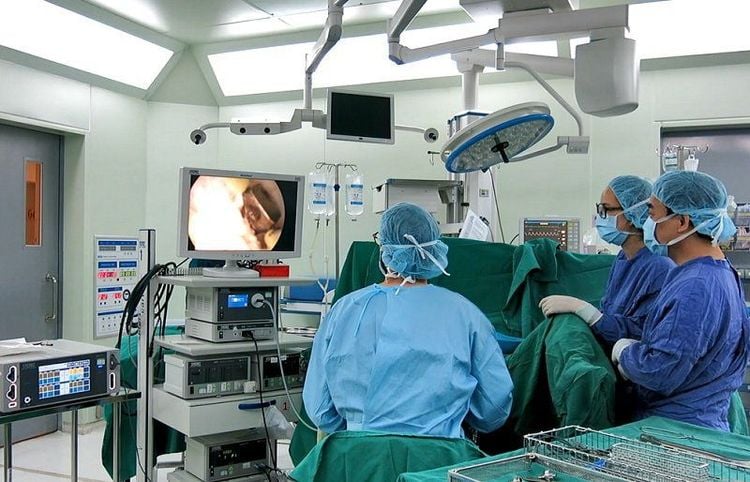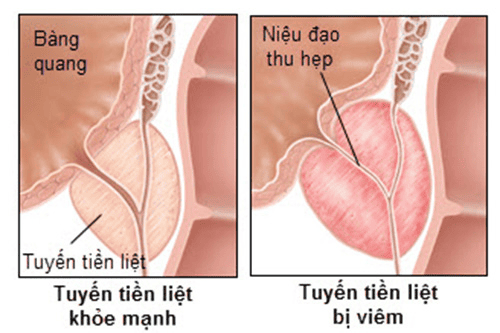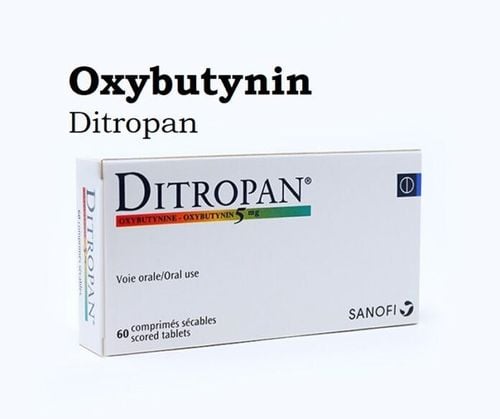This is an automatically translated article.
The article is expertly consulted by MSc Tran Thanh Hung - Department of General Surgery, Vinmec Ha Long International General Hospital.Benign prostatic hypertrophy is a disease caused by an increase in the size of the prostate gland in men. Treatment of benign prostatic hypertrophy can be with medication or using some modern surgical methods.
1. Benign prostatic hypertrophy
It is estimated that more than 50% of men over 50 years of age, and more than 70% of men over 60 years of age, have an enlarged prostate. The risk of the disease increases with age. However, sometimes we can also see the disease in some young people.Common manifestations of the disease:
Difficulty urinating often Urinary retention Urinary urgency, especially at night, having to get up to urinate. Other manifestations: Sudden urge to urinate and can't hold back for a few minutes; After urinating not feeling comfortable but still feeling the need to urinate, there may also be blood in the urine, urinary infection. However, because the above symptoms often develop slowly, the patient can get used to it and be difficult to recognize. Many patients come to the clinic late when the tumor is too big and complications of bladder and kidney failure become very complicated.
Benign prostatic hypertrophy is a rather dangerous disease if not detected and treated promptly, therefore, in male patients. Therefore, when there are abnormal urinary symptoms, the patient should be seen by a doctor immediately so that he can be screened and treated appropriately.
2. Treatment methods for benign prostatic hypertrophy at Vinmec
Treatments for prostate enlargement will vary depending on the patient's condition.
With mild disease, the patient can be treated medically with drugs as prescribed by the doctor and assess the disease progression after 6 months to 1 year on urinary problems.
In case the patient is severe, has repeated acute urinary retention, the tumor size is large, or the patient has a number of other diseases that cannot be met by medical treatment, the doctor may appoint surgery.
Modern surgical methods are being used in Vinmec international hospital system:
Treatment of prostatic hypertrophy with Bipolar bipolar knife Benign prostatic endoscopy Evaporating endoscopy laser prostate
2.1. Treatment of prostatic hypertrophy with Bipolar knife

This method is suitable for patients with prostate enlargement (usually from 25 to 250 grams). The patient had an enlarged prostate gland with bladder stones. Patients with urological ultrasound have residual urine in the bladder greater than 100ml. Patients with acute urinary symptoms accompanied by renal failure, blood test creatinine increased. There are urinary disorders (nocturia, urinary frequency, urinary incontinence) affecting the quality of life. Expect to be treated surgically to improve quality of life. Advantages of the method Less bleeding, less pain. Short hospital stay (50% of patients after treatment are discharged on the same day, 40% can stay in the hospital for 1-2 days). No need to put a bladder drain after the treatment.
2.2. Endoscopic evaporative benign prostatic hyperplasia

Benign prostatic evaporative endoscopic method is suitable for patients with complicated benign prostatic hypertrophy - Complete urinary retention, even after urethral catheterization - Incomplete urinary retention with water residual urine after urinating, failed internal treatment - Recurrent hematuria due to UTI - Bladder diverticulum, bladder stones due to UTI - Recurrent urinary tract infection - Renal failure (recommended renal failure before treatment is recommended) endoscopic resection) Benign prostatic hypertrophy affects health, sleep or interferes with work (relatively). Advantages of the method The patient has no incision, good psychological and aesthetic feeling. Post-surgery is gentle due to less pain, quickly regains movement, thus avoiding complications due to long lying down, short hospital stay, patients quickly urinating in a natural way. The technique is similar to transurethral ablation technique, safe because the risk of bleeding and perforation is very low, and the cost is low because there is almost no need for continuous washing after surgery. Using isotonic saline solution as an alternative to hypotonic saline solution, eliminates the risk of endoscopic syndrome. No electric current flows through the patient's body, reducing the risk of electrical burns, urethral stricture or bladder neck fibrosis after surgery. Good hemostasis, reduced urinary circulation and short hospital stay. Using 0.9% sodium chloride solution without ions (Glycine or Mannitol) should not worry about passive absorption of hypotonic fluids into the body. There is no current (such as a unipolar knife) through the patient's body, so the risk of electrical burns at the contact site of the electrode plate is reduced, reducing the danger for patients with pacemakers.
2.3. Endoscopic laser vaporization of the prostate
Is a new technique applied on the basis of endoscopic urethroscopic prostatectomy with bipolar knife, deployed by Vinmec Times City in 2018 and in 2019 and deployed in other Vinmec hospitals.
Subjects of application Patients with complete urinary retention, even after urethral catheterization. Incomplete urinary retention with residual urine after urinating, failure of medical treatment. Recurrent hematuria due to an enlarged prostate gland. Bladder diverticulum, bladder stones due to an enlarged prostate gland. Recurrent urinary tract infections. Prostate enlargement affects health, sleep or interferes with work. The outstanding advantage of this method Laser ablation surgery for prostate enlargement, which is already a minimally invasive technique, follows a natural path, replacing open surgery to remove prostate tumors with many complications. , is more invasive in patients who are usually elderly. With the coagulation and evaporation heat of the laser, the surgical process of prostate tumor is better hemostasis, less bleeding, faster recovery, and reduced risk of bladder neck stenosis, post-operative sphincter disorders. The patient can withdraw the catheter after 1 day, discharged from the hospital after 2-3 days.
The results are functionally equivalent to the classical method, with outstanding advantages in terms of blood loss, the need for blood transfusion for surgery, which is a big problem in surgery for patients.
3. Why should you be treated at Vinmec International General Hospital?

Specialized urological examination. Urinary tract ultrasound. Quantification of total PSA. Quantification of free PSA. Urine culture. To help detect possible urinary tract diseases early. Especially prostate diseases (benign prostatic hypertrophy, prostate cancer) and urinary stone pathologies.... thereby helping customers to take preventive measures.
Please dial HOTLINE for more information or register for an appointment HERE. Download MyVinmec app to make appointments faster and to manage your bookings easily.














